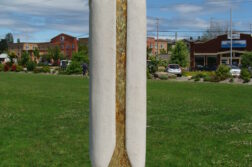No Consensus on the Meaning of “Gay”
To the Editor:
One thing that struck me in the new issue [Sept.-Oct. 2021] is that the word “gay” still has no common meaning among LGBT writers, to the point that there is real confusion.
In the Correspondence section, Franco Mormondo took exception to Vernon Rosario’s claim that it’s wishful thinking to characterize the medieval “brother-making ceremony” as a gay union. “Not so,” Mormondo objects: “these unions were seen as ‘gay’ (i.e., involving same-sex genital behavior)” according to various contemporary sources. Rosario would be the last to argue that men didn’t engage in “same-sex genital behavior” before the 19th century. He would argue that being “gay” means having a conception of oneself as fundamentally different from the sexual norm, which clearly is not Mormondo’s understanding at all.
Next, Andre Bagoo finds fault with Arnold Rampersad’s biography of Langston Hughes because, based on his assessment of the evidence, Rampersad refrains from declaring him as “gay.” Bagoo acknowledges that Hughes frequented bordellos with female prostitutes as evidence that the poet was not asexual. That he had a sexual interest in men is also quite likely, but it does not appear to have been exclusive. In any case, it is the sexual desire for men (whether acted upon or not) that makes someone “gay” in this assessment—not, again, the perception of oneself as fundamentally different from a sexual norm.
Alan Contreras tells us that the Theban 300 constituted “a gay male regiment.” Again, that they had sex with each other doesn’t seem to be in dispute at all. But were they “gay” in the modern sense of having a particular sexual identity? It seems we continue to use the term to refer to a type of sexual activity regardless of the social context.
Richard Berrong, Cuyahoga Falls, OH
Cary Grant’s Madcap Romp (plus 2)
To the Editor:
Every time a new biography of Cary Grant is published, the question is raised whether he was or wasn’t gay. In Allen Ellenzweig’s review of Scott Eyman’s Cary Grant: A Brilliant Disguise (Sept.-Oct. 2021), the tale is retold that late in life Cary “unburdened himself” to his friend Bill Royce that “he had been basically gay as a young man, later bisexual, still later straight.”
Ellenzweig reports that when Cary’s first wife-to-be, Virginia Cherrill, sailed to England in 1934 to avoid his “obsessive pre-marriage demands,” Cary hastened to follow her aboard another ship, the S.S. Paris. But he didn’t travel alone; he was accompanied by the handsome, rugged Randolph Scott, the actor with whom Cary shared his home. Although they admitted that they lived together and were featured in “fun photos” in the glossy movie magazines of the day, Cary and Randy laughed off their living arrangement as merely convenient for them, two bachelors.
Also noted by Ellenzweig is that a third man joined Cary in his madcap chase after Virginia: David Manners. He was a handsome Canadian-born actor whose Hollywood career began two years before Cary’s when gay film director James Whale saw him on Broadway and asked him to appear in the 1930 war film Journey’s End. He’s remembered for playing opposite Bela Lugosi in 1931’s Dracula, among other 1930s films.
The review notes that the three men traveled first class and hosted a party but doesn’t describe what else this handsome, physically fit threesome did aboard the ship. It’s obvious why Manners joined his fellow actors for the voyage. Undoubtedly he knew Cary and Randy back in Hollywood, and chances are he was part of a clique of gay actors and who had previously enjoyed one another’s favors.
Sam-Steven Siporin, Woodland Hills, CA



